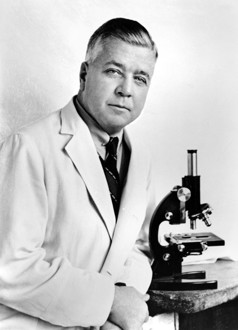The Birth of Modern Virology

Rivers, Thomas
Courtesy of the Rockefeller Archive Center
In the 1920s virology was not an established discipline. Although researchers could study the effects of viral diseases in humans, animals, and plants, they had no criteria to describe viruses chemically--in fact, the very definition of a virus was a subject for debate! The best scientists could do was to say that, if an infectious agent passed through a fine porcelain filter that held back bacteria, then it was probably a virus ("a filterable agent"). In 1926, Thomas M. Rivers (1888-1962), director of the Rockefeller Hospital, made a bold statement about the essential nature of viruses that set the course of virology for decades to come. He said: "Viruses appear to be obligate parasites in the sense that their reproduction is dependent on living cells."
In stating that viruses needed living cells in order to replicate, Rivers was contradicting many workers in the field, including Simon Flexner, the director of the Rockefeller Institute, who claimed to have isolated and cultivated the polio virus in a cell-free medium. But Rivers had both laboratory and clinical experience on which to base his view. When, in 1926, the Society of American Bacteriologists invited him to organize a symposium on viruses, and deliver a lecture, he reviewed the body of knowledge on viruses. Several observations on the problem of growing viruses in the laboratory led him to his conclusion: the difficulty of cultivating viruses on artificial media could not be explained; although viruses were small, size should not prevent their cultivation; viruses were not particularly delicate or susceptible to destruction during laboratory procedures; nor had any viruses been found multiplying free in nature. His synthesis of the state of virology was published in a landmark book, Filterable Viruses, in 1928. Rivers' hypothesis led to many advances in the culturing and characterization of viruses that cause human disease.
Thomas M. Rivers received the BA from Emory College in 1909 and the MD from The Johns Hopkins University Medical School in 1915. After an internship and residency in pediatrics, he joined the Army in 1918, serving on commissions with the U.S. Army Medical Corps that investigated outbreaks of pneumonia and empyema. He returned to Johns Hopkins for a research appointment in 1919, and joined the Rockefeller Institute Hospital in 1922. In 1937 Rivers became director of the hospital, a position he held until 1953, when he became Vice President and Director of the Institute. He retired in 1955. Rivers was elected to the U.S. National Academy of Sciences. He served as president of the American Society for Clinical Investigation, the American Association of Immunologists, the Society of American Bacteriologists, and the Third International Congress for Microbiology, and received honorary degrees from Emory University, the University of Rochester, the University of Chicago, and the Rockefeller Institute.
Selected Publications
Rivers TM. Filterable Viruses: A critical review. J Bacteriol, 1927, 14:217-258
http://jb.asm.org/cgi/reprint/14/4/217
Rivers TM. Some general aspects of pathological conditions caused by Filterable Viruses. Am J Pathol, 1928, 4:91
Rivers, TM, ed. Filterable Viruses. Baltimore: Williams and Wilkins, 1928
Further Reading
Horsfall FL Jr. Thomas Milton Rivers (1888-1962): A Biographical Memoir. Washington, DC: National Academy of Sciences, 1965, 38:262-294
Benison S. Tom Rivers: Reflections on a Life in Medicine and Science. An Oral History Memoir. Cambridge, MA: The MIT Press, 1967
